12 AI Sales Intelligence Tools for Smart Prospecting in 2025
I’ve been in sales long enough to see one thing stay the same, that is prospecting sucks when you don’t know where to focus.
You spend hours chasing leads that you never buy.
You copy-paste messages that don’t land.
And you end up with a pipeline that looks busy but never closes.
That’s why AI sales intelligence doesn’t just give you data. It gives you clarity.
Alt Text: Review on AI sales intelligence tools in reddit
It tells you which accounts are worth chasing, which buyers are showing intent, and what signals actually matter.
That’s the difference between wasting time and booking meetings.
👉 But first, let’s get clear on what sales intelligence really is and why you can’t afford to ignore it this year.
TL;DR - 12 Best AI Sales Prospecting Tools
TL;DR — Best AI Sales Intelligence Tools (2025)
If you want smarter prospecting in 2025 with AI that finds real buyers, here’s how the top tools compare:
Salesforge – Best overall for multi-channel prospecting with deliverability built in (Primebox™ + Warmforge), unlimited LinkedIn/email senders, AI lead scoring, and optional AI SDR (Agent Frank).
Apollo.io – Affordable all-in-one with a large database, email sequences, enrichment, and dialer. Great entry point for SMBs.
ZoomInfo – Enterprise-grade data depth and intent signals. Best for teams that want verified contacts at scale, though contracts are expensive.
LinkedIn Sales Navigator – Most accurate self-updated buyer data from LinkedIn profiles. Ideal for finding decision-makers and tracking job changes.
Outreach.io – Strong for scaled sales engagement with AI-powered sequences, deal insights, and forecasting. Best for mid-to-large teams.
HubSpot Sales Hub – Combines CRM + AI sales intelligence in one. Easy to use with AI intent signals and strong integrations.
Gong – Leading conversation intelligence platform. Records calls, analyzes sentiment, and helps managers coach reps.
Amplemarket – AI-guided multichannel outreach with intent signals, enrichment, and deliverability checks. Good for scaling outbound.
Cognism – GDPR-compliant data leader in EMEA with Diamond Data® phone verification. Best for teams targeting Europe.
Lusha – Budget-friendly direct dials and emails with Chrome extension. Good as a secondary data source.
Seamless.ai – Real-time contact search and AI research assistant. Scalable, but credit usage and upselling can be issues.
Clay – Workflow-first platform for data-savvy teams. Connects 100+ data providers with AI personalization and custom triggers.
What Is AI Sales Intelligence?
AI sales intelligence is how top sales teams find real buyers, not just names on a list.
It goes beyond scraping emails. These tools analyze who’s likely to buy, when to reach out, and what message will land.
It tells you:
- Who’s worth contacting
- When to reach out
- What to say that actually gets a reply
Here’s what it actually does under the hood:
- Pulls real-time data from LinkedIn, websites, job boards, emails, and tools your buyers use
- Detects buyer intent by tracking signals like new funding, hiring surges, tech installs, or role changes
- Recommends outreach by scoring leads, timing contact, and even writing context-aware emails
Without it, you chase cold leads.
With it, you spend time only on high-intent prospects, leading to faster pipeline movement and better close rates.
👉 Next, let’s break down what features actually matter in an AI sales intelligence tool and what’s just noise.
Key Features You Actually Need in an AI Sales Intelligence Tool
In 2025, your AI sales intelligence tool should do more than surface contacts. Here’s what you should expect:
- Real-Time Lead Scoring: Ranks leads automatically based on behavior, firmographics, and engagement. Saves time by removing guesswork.
- Verified Intent Signals: Tracks buyer behavior across multiple channels: funding news, tech installs, job changes, and website visits.
- Native CRM and Outreach Integrations: Connects directly with tools like Salesforce, HubSpot, LinkedIn, and email. No manual exporting or switching tabs.
- Firmographic and Technographic Enrichment: Adds context like team size, revenue, tools used, and decision-maker roles to help you qualify and personalize.
- Trigger-Based Alerts: Notifies you when key events happen — new tech adoption, hiring, territory expansion — so you act on time.
- Multi-Channel Engagement Suggestions: Recommends not just what to say, but where to say it — email, LinkedIn, or phone — based on the lead’s profile.
- Contact Verification and Freshness: Ensures phone numbers, emails, and job titles are current, so you avoid bounces and wasted effort.
- Message and Channel Recommendations: Uses AI to suggest outreach sequences, follow-ups, and touchpoints based on past conversions.
If a tool doesn’t do most of this, you’ll spend more time cleaning lists than closing deals.
Now, let’s break down the best AI sales intelligence tools built for this exact workflow.
12 Best AI Sales Intelligence Tools in 2025
- Salesforge
- Apollo.io
- ZoomInfo
- LinkedIn Sales Navigator
- Outreach.io
- Hubspot Sales Hub
- Gong
- Amplemarket
- Cognism
- Lusha
- Seamless.ai
- Clay
#1 Salesforge. Built for Prospecting With Data, Deliverability, and Automation
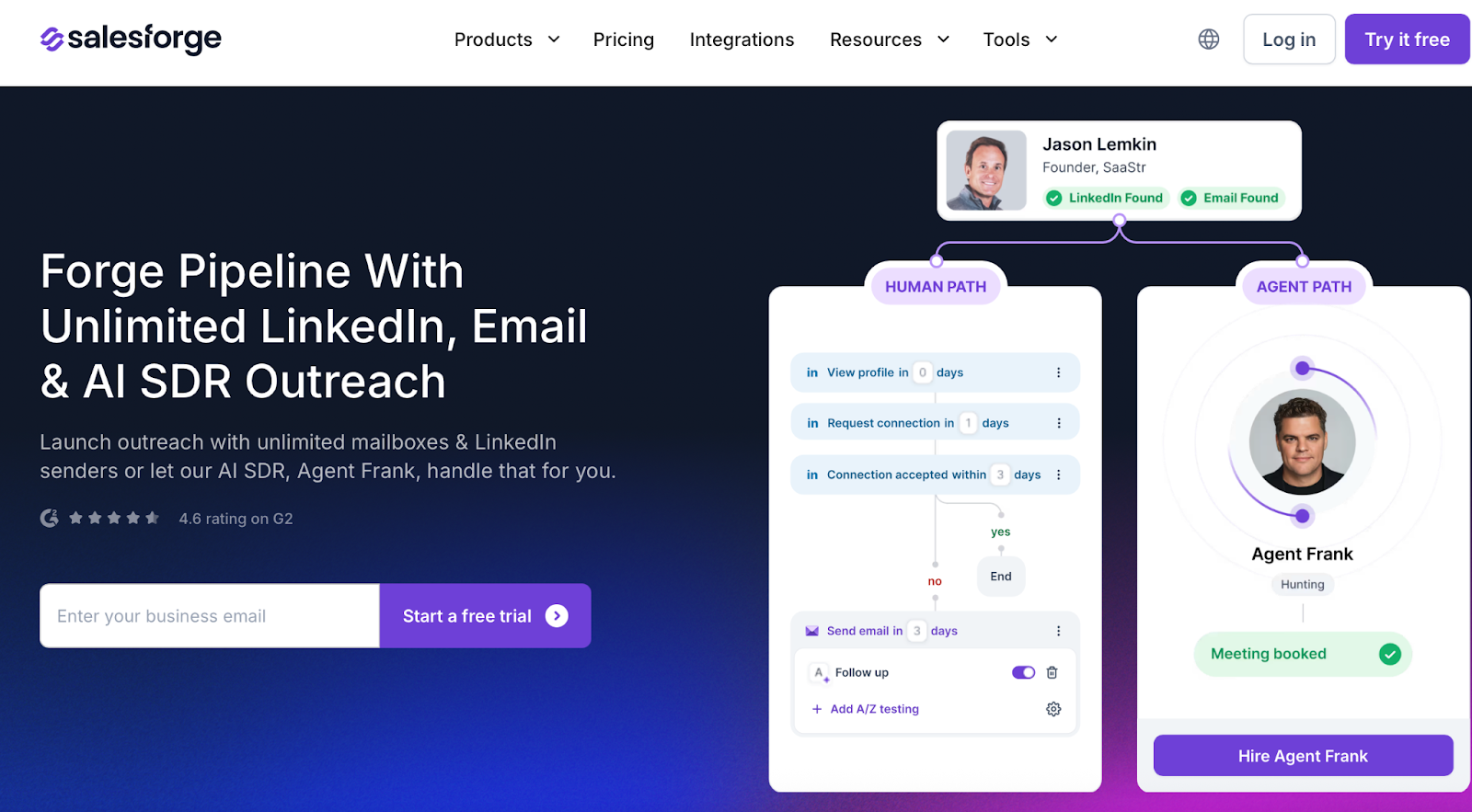
Salesforge isn't just another sales tool, it's a full-stack sales prospecting engine.
It solves the 3 biggest problems in outbound today:
- Who to contact
- What to say
- How to land in the inbox
Unlike tools that only store leads or send sequences, Salesforge combines lead intelligence, email infrastructure, and AI outreach agents into one workflow.

What Makes Salesforge Unique for Prospecting?
- AILead Scoring: Get automatic ranking of prospects based on buying intent, past behaviors, and firmographic filters.
No more guessing who to contact first.
- Unlimited Mailboxes + LinkedIn Senders: Rotate through unlimited inboxes and LinkedIn profiles to avoid volume limits and spam filters.
Scale safely without paying extra per mailbox.
- Deliverability Infrastructure Included: Comes bundled with Warmforge (email warmup), Mailforge (SMTP-ready mailboxes), and Infraforge (private IP infra).
This eliminates technical setup and reduces bounce rates.
- Primebox™ Rotation: Automates which mailbox gets used based on reputation, sending limits, and reply behavior.
Ensures consistent inbox placement.
- Multi-Language Sequences: Run cold outreach in 20+ languages. Useful for global teams or localization workflows.
- Agent Frank (Optional AI SDR): Handles prospecting, sending, and follow-ups from cold to booked call.
Think of it as a full-time rep who doesn’t sleep.
- Real-Time Prospect Reaction Analysis: Built-in sentiment tracking to identify warm replies, objections, and positive signals, so you know who’s engaging.
Salesforge Pricing

- Pro Plan – $48/month → For small teams or solo users. Includes 1,000 contacts and 5,000 emails.
- Growth Plan – $96/month → For scaling teams. Includes 10,000 contacts, 50,000 emails, API access, and LinkedIn senders.
- Agent Frank – $499/month (quarterly) → Adds an AI sales agent for automated prospecting in 20+ languages.
(Annual plans include 2 months free.)
Pros and Cons of Salesforge
In short,
Salesforge is built for outbound teams that want smarter targeting, personalized outreach at scale, and inbox-first delivery.
If your cold emails aren’t converting because of poor targeting or spam issues, this is the tool that solves both.
👉 Use Salesforge if you’re serious about scaling pipeline without burning domains or wasting time on the wrong leads.
#2 Apollo.io
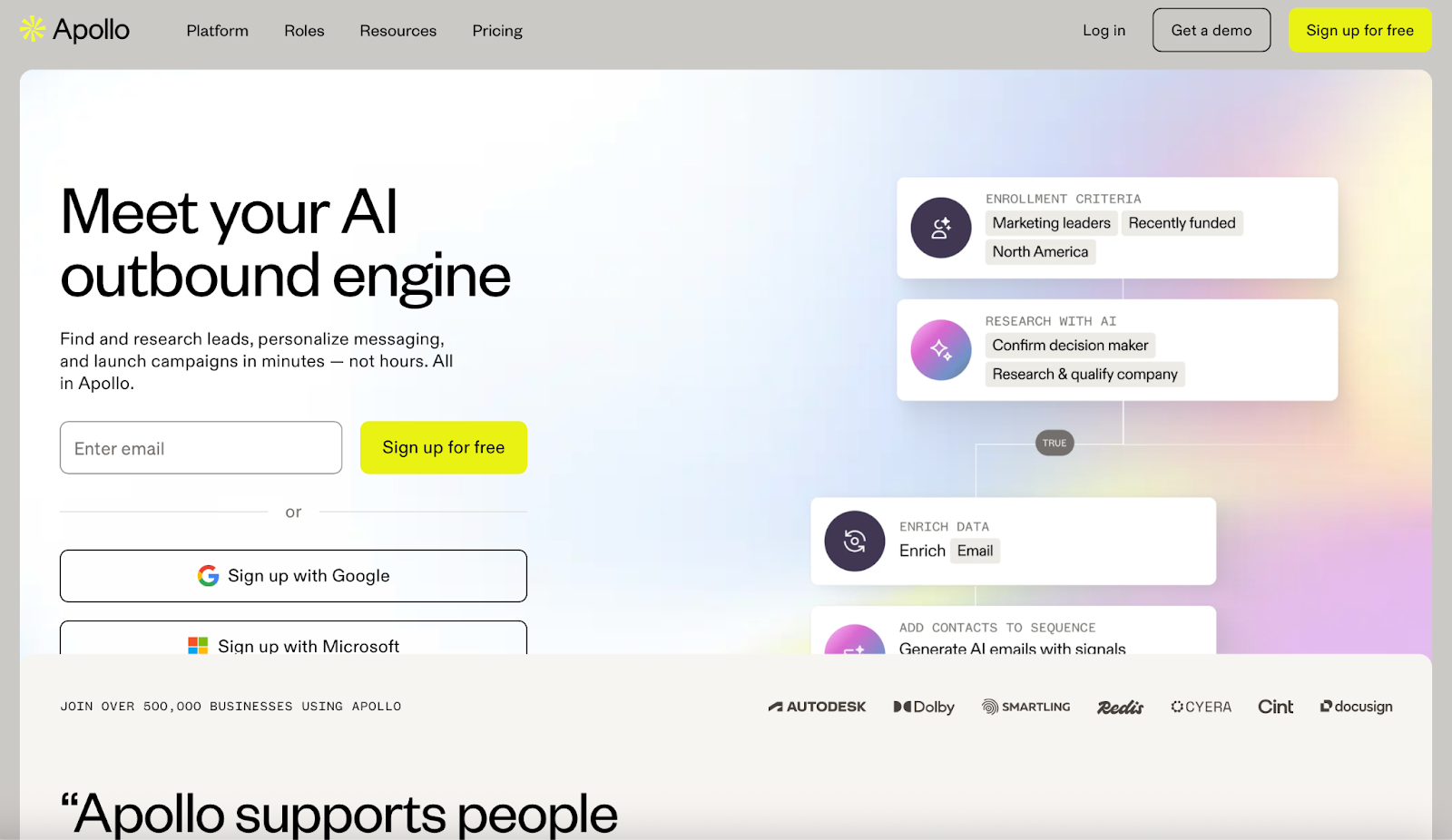
Apollo.io is one of the most widely used AI sales intelligence tools for prospecting in 2025.
It stands out because it combines a large contact database with outreach automation and CRM features, making it a popular option for SMBs that want an affordable all-in-one platform.
What Features Apollo.io Offer?
- Contact Database & Enrichment – Source leads and enrich CRM records with firmographic and technographic details.

- AI Email Composer – Create personalized emails at scale.
- Multi-Channel Outreach – Sequences that include email and dialer options.
- CRM Integrations – Works with Salesforce, HubSpot, and Pipedrive.
- Reporting & Analytics – Track engagement, email opens, and team performance.
- Chrome Extension – Capture contacts directly from LinkedIn and Gmail.
Pricing of Apollo.io
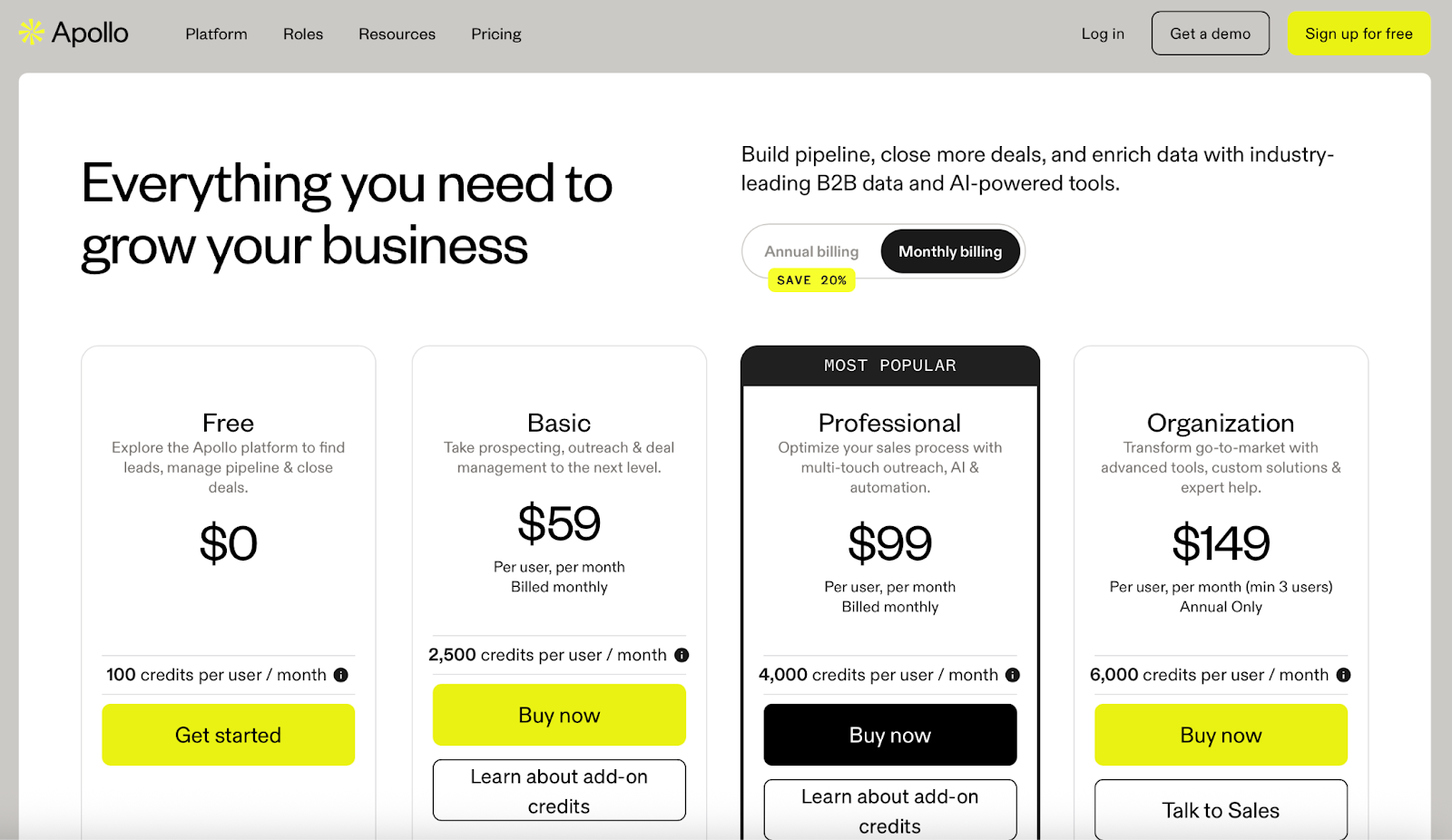
- Free Plan – $0/month
100 credits, 2 sequences, basic filters, Gmail integration.
- Basic Plan – $59/user/month
2,500 credits, CRM integrations, enrichment, meeting scheduling.
- Professional Plan – $99/user/month
4,000 credits, unlimited sequences, 5 mailboxes, US dialer, AI insights.
- Organization Plan – $149/user/month (annual only, min 3 users)
6,000 credits, international dialer, 15 mailboxes, advanced reports, and SSO.
(Annual billing saves ~20%.)
Pros and Cons of Apollo.io

In short,
Apollo.io offers a balance of features, affordability, and accessibility, making it appealing for smaller teams that want to handle prospecting and outreach from one platform.
However, users often point out data quality concerns and customer support challenges.
It’s a solid entry-level AI sales intelligence tool, but businesses with global or high-volume prospecting needs may find its limitations more noticeable.
Also Read: 5 Best Apollo.io Alternatives & Competitors in 2025
👉 Next, let’s look at ZoomInfo, often compared with Apollo for its stronger data accuracy but much higher cost.
#3 ZoomInfo
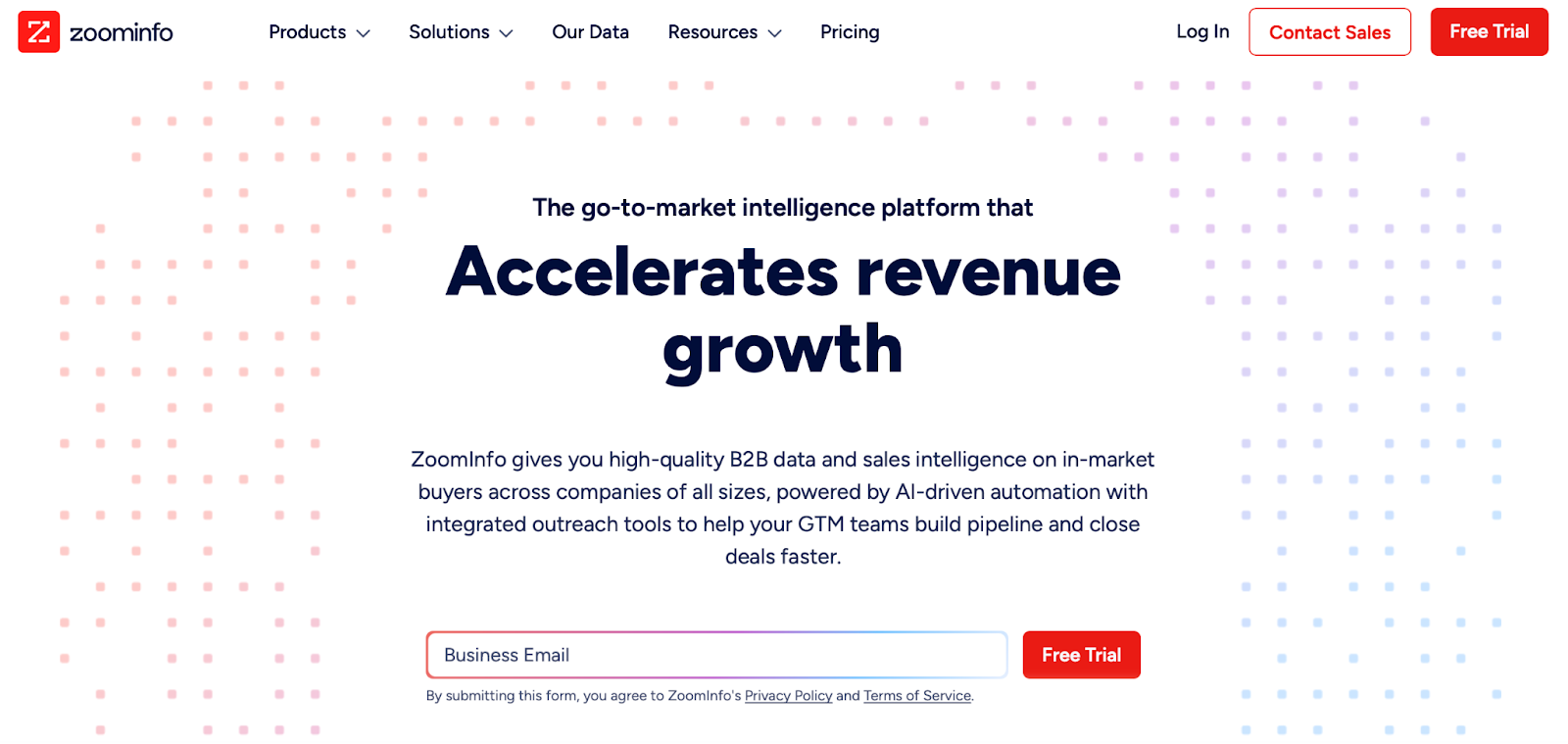
ZoomInfo is one of the most recognized AI sales intelligence tools for prospecting in 2025.
It’s known for its large database, extensive company insights, and integrations that support sales and marketing teams.
For businesses that prioritize data depth and coverage, ZoomInfo often comes up as the go-to choice, despite its higher cost.
Apollo vs ZoomInfo
What Features ZoomInfo Offer?
- Extensive Database – Access to millions of B2B contacts and companies.
- Accurate Contact Information – Verified emails, direct dials, and mobile numbers.
- Buyer Intent Data – Signals that help identify when accounts are actively searching for solutions.
- Company Insights – Firmographic and technographic details to better qualify leads.
- Integrations – Works with major CRMs and sales engagement platforms.
- Conversation Intelligence – Tools like Chorus for analyzing calls and interactions.
Pricing of ZoomInfo
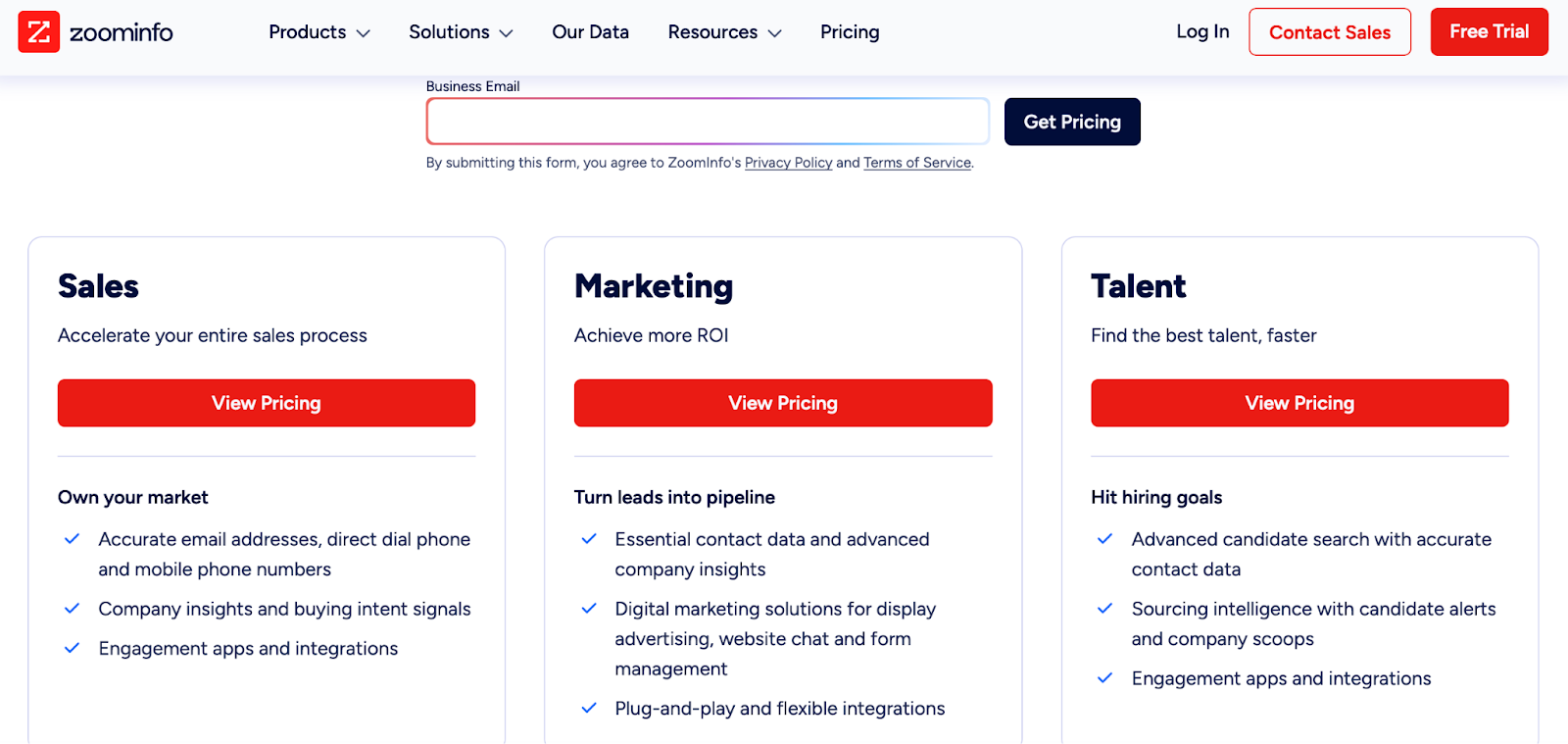
ZoomInfo does not publish fixed pricing.
Costs are based on packages (Sales, Marketing, Talent, RevOps) and usage.
- Reported pricing from users suggests $15,000+ per year for small teams.
- Larger packages can cost significantly more depending on seats and data volume.
- No monthly billing options, contracts are typically annual.
Pros and Cons of ZoomInfo

ZoomInfo stands out for its accuracy and coverage, making it a leading choice for enterprises and large sales teams that can afford it.
Its buyer intent data and integrations add depth for prospecting, but the price point is often the biggest barrier for smaller businesses.
For teams looking at AI sales intelligence tools in 2025, ZoomInfo is a powerful option, but only if budget is less of a concern.
7 Best ZoomInfo Alternatives and Competitors of 2025
👉 Next, let’s look at LinkedIn Sales Navigator, a tool built directly into the LinkedIn ecosystem that many sales teams rely on for prospecting accuracy.
#4 LinkedIn Sales Navigator

LinkedIn Sales Navigator is included because it offers something other platforms can’t: real-time, self-updated data directly from LinkedIn profiles.
For prospecting in 2025, this makes it one of the most accurate sales intelligence tools, especially for finding decision-makers and tracking job changes.
What Features LinkedIn Sales Navigator Offer?
- Accurate and Updated Data – Contacts update their own LinkedIn profiles, making it one of the most reliable data sources.
- Advanced Search Filters – Over 50 filters to identify prospects by role, company, geography, or industry.
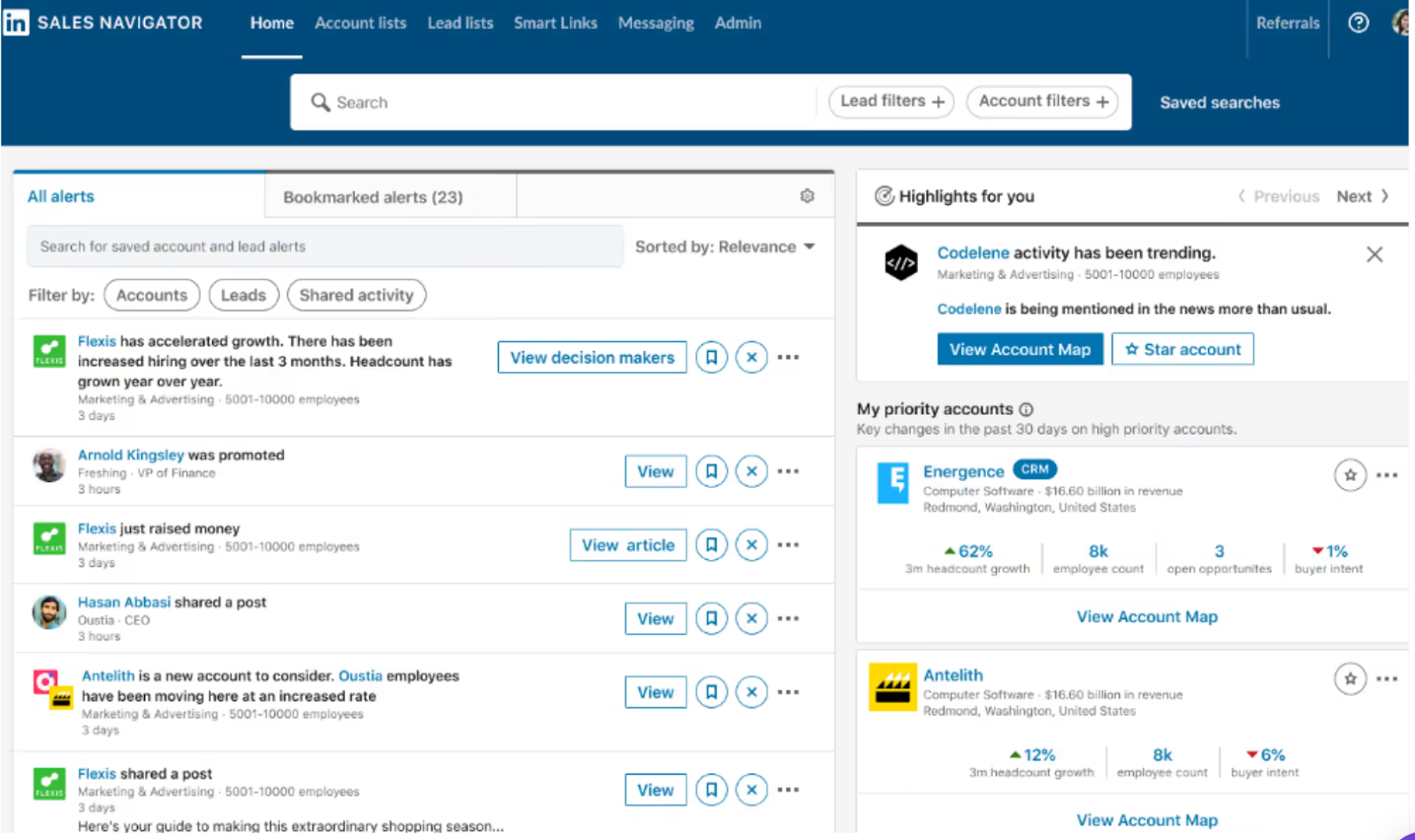
- InMail Messaging – Ability to send private messages even without a direct connection (50 per month).
- AI-Powered Insights – New features like Account IQ and Lead IQ for summaries and recommendations.
- CRM Integrations – Syncs lead and account records into Salesforce and other CRMs.
- Job Change and Account Alerts – Notifications when prospects move roles or companies.
Pricing of LinkedIn Sales Navigator
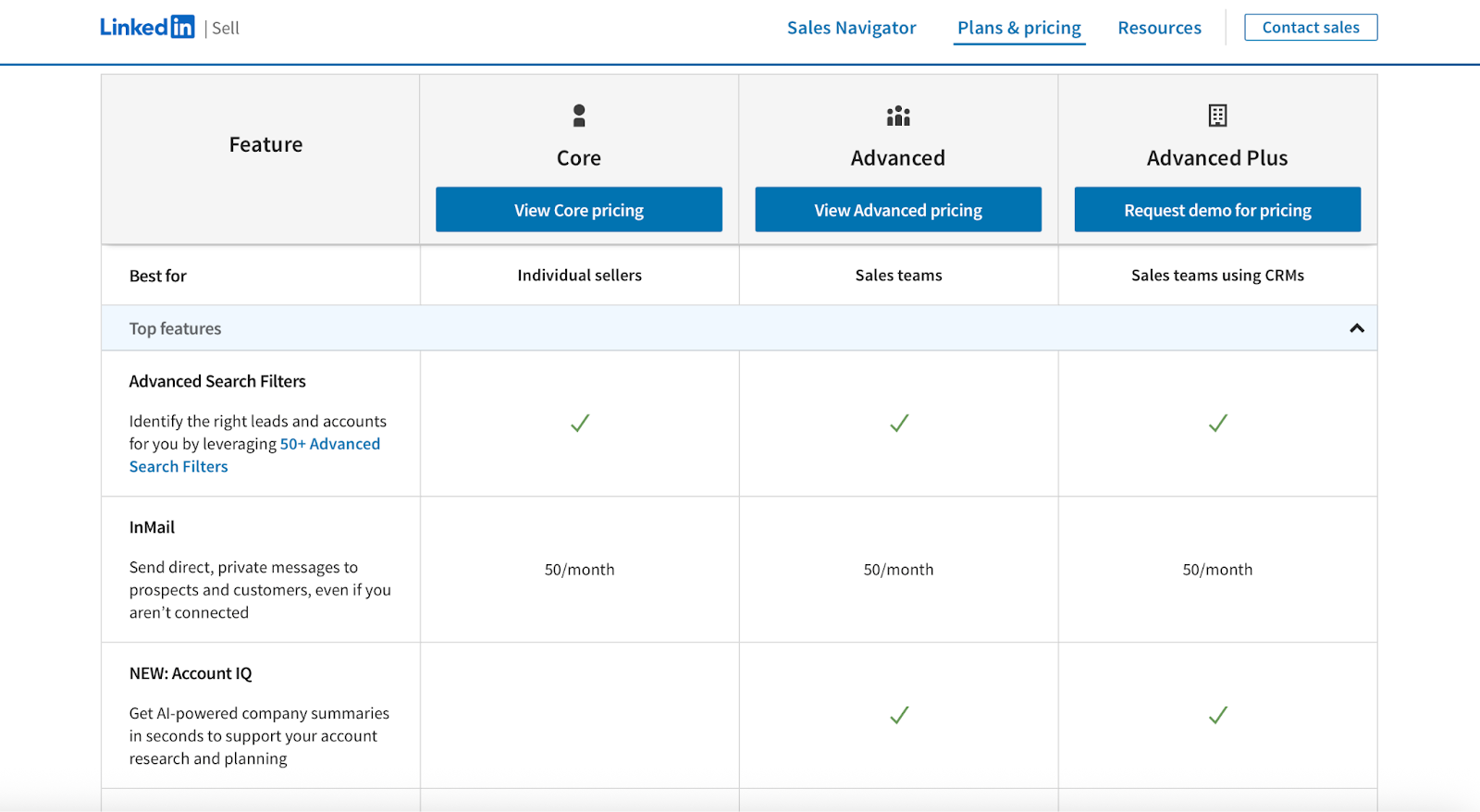
- Core Plan – Best for individual sellers. Pricing varies by region.
- Advanced Plan – Designed for sales teams, includes more integration and workflow features.
- Advanced Plus Plan – Enterprise-level package with deeper CRM integrations. Pricing on request.
Pros and Cons of LinkedIn Sales Navigator

In short,
LinkedIn Sales Navigator is a strong AI sales intelligence tool for prospecting when accuracy and decision-maker access matter most.
Its filters and alerts make it easier to find and track leads, though the price and InMail limits can hold back heavy users.
It works best when paired with other tools for outreach and follow-up, making it a valuable part of a modern sales stack in 2025.
10 Strong LinkedIn Sales Navigator Alternatives & Competitors for Sales Teams
👉 Next, let’s look at Outreach, a platform known for its sequencing and automation features that support prospecting at scale.
#5 Outreach.io
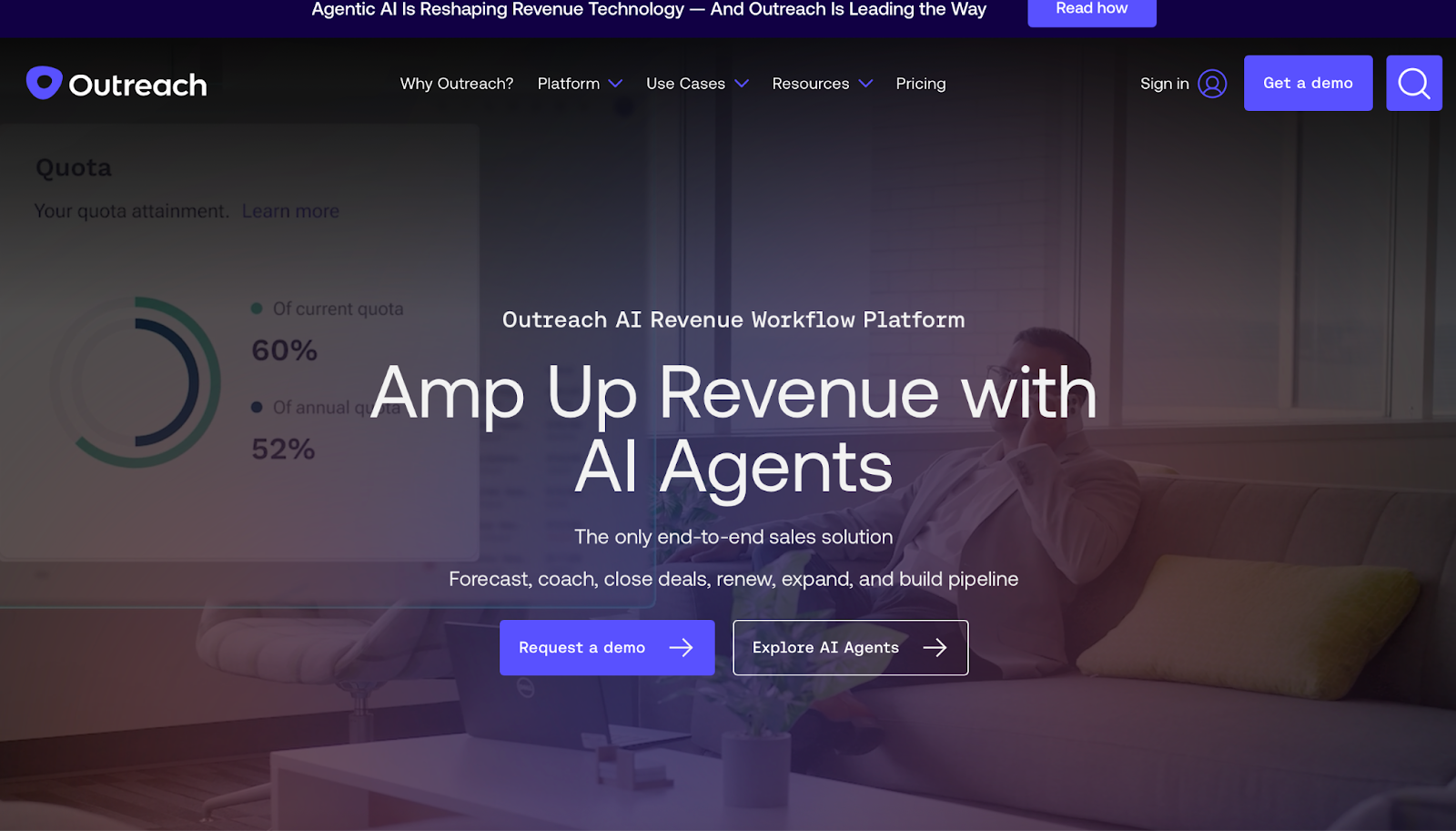
Outreach is included because it’s one of the most established sales engagement platforms with AI-driven intelligence features.
For prospecting in 2025, it helps teams scale outreach with sequences, call summaries, deal health scoring, and forecasting insights.
While not purely a data provider, its strength lies in combining AI-driven execution with sales intelligence signals.
What Features Outreach Offer?
- Automated Sequences – Email and task automation to manage high-volume prospecting.
- AI-Powered Call Assist – Real-time call summaries, Q&A, and coaching through its Kaia feature.
- Deal Intelligence – Smart deal assist, health scores, and pipeline tracking.
- Forecasting Tools – Scenario modeling and AI projections for more predictable pipelines.
- CRM Sync – Integrations with Salesforce and other CRMs to manage activities in one place.
- AI Agents (Amplify) – Prospect enrichment, personalization, and engagement powered by AI.
Pricing of Outreach

Outreach follows per-user pricing, but it does not publish fixed rates. Packages include:
- Engage → Sales engagement (sequences, templates, CRM sync).
- Call → Integrated dialer and call intelligence features.
- Meet → Conversation intelligence with AI call summaries and insights.
- Deal → Deal health scoring and pipeline management.
- Forecast → Automated roll-ups and AI-driven forecasting.
- Amplify → AI agents for enrichment, personalization, and deal support.
Pricing is custom, but users often mention it is on the higher end compared to competitors.
Pros and Cons of Outreach

In short,
Outreach is best described as a sales engagement platform with embedded AI sales intelligence.
It helps teams manage large-scale prospecting while offering insights into deals and pipeline health.
The trade-off is complexity and cost, which makes it better suited for mid-sized to large teams rather than early-stage startups.
For 2025, it remains a go-to option for companies that want AI-backed engagement and forecasting in one place.
Our Tested 5 Outreach Alternatives For Easy + Effective Cold Outreach in 2024
👉 Next, let’s move on to HubSpot, which combines CRM functionality with AI sales intelligence features for prospecting.
#6 Hubspot Sales Hub
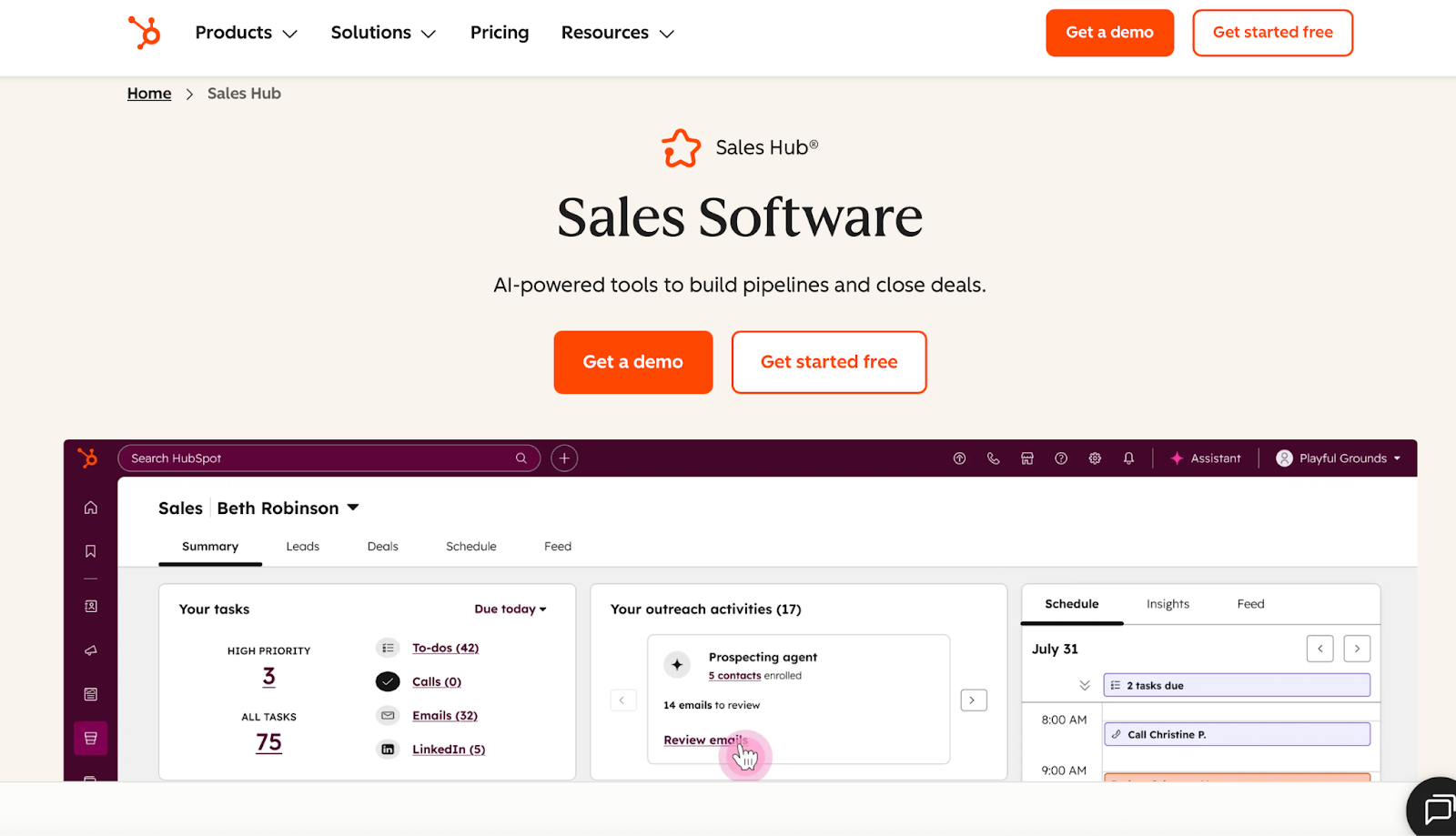
HubSpot Sales Hub is included because it brings sales intelligence, CRM, and automation into one platform.
For prospecting in 2025, its strength lies in helping teams manage leads, track outreach, and use AI-powered features like intent signals and prospecting agents, all inside the same ecosystem.
What Features HubSpot Sales Hub Offer?
- Smart CRM – Centralized lead and account management with activity tracking.
- AI Prospecting Agent – Helps identify and prioritize high-value leads.
- Email Tracking & Templates – Track opens and clicks, with reusable templates for faster outreach.
- Sequences & Automation – Automate follow-ups, tasks, and workflows.
- Call Transcription & Coaching – AI-powered call summaries and coaching playlists.
- Forecasting Tools – Deal tracking and pipeline forecasting to support revenue planning.
- Integrations – Works with 1,500+ apps including Salesforce, LinkedIn, and Microsoft Teams.
- Educational Resources – HubSpot Academy offers free training and certifications.
Pricing of HubSpot Sales Hub
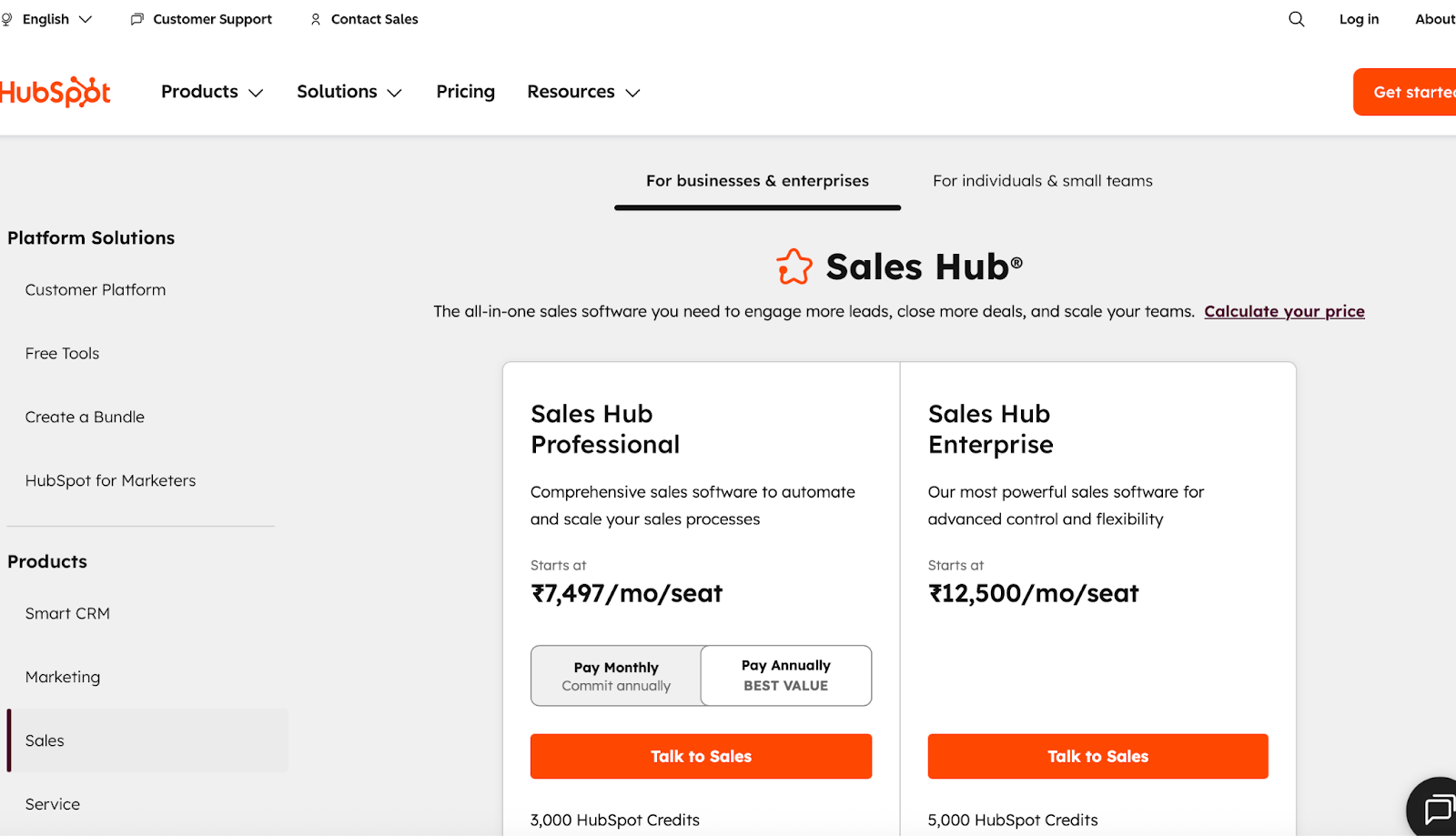
- Free Plan – ₹0/month → Basic CRM and sales tools for up to 2 users.
- Starter Plan – from ₹752/month per seat → Adds e-signatures, conversation routing, and simple automation.
- Professional Plan – from ₹7,497/month per seat (plus onboarding fee) → Includes advanced automation, playbooks, forecasting, call transcription, and coaching tools.
- Enterprise options → Available for larger teams, with custom pricing.
Pros and Cons of HubSpot Sales Hub
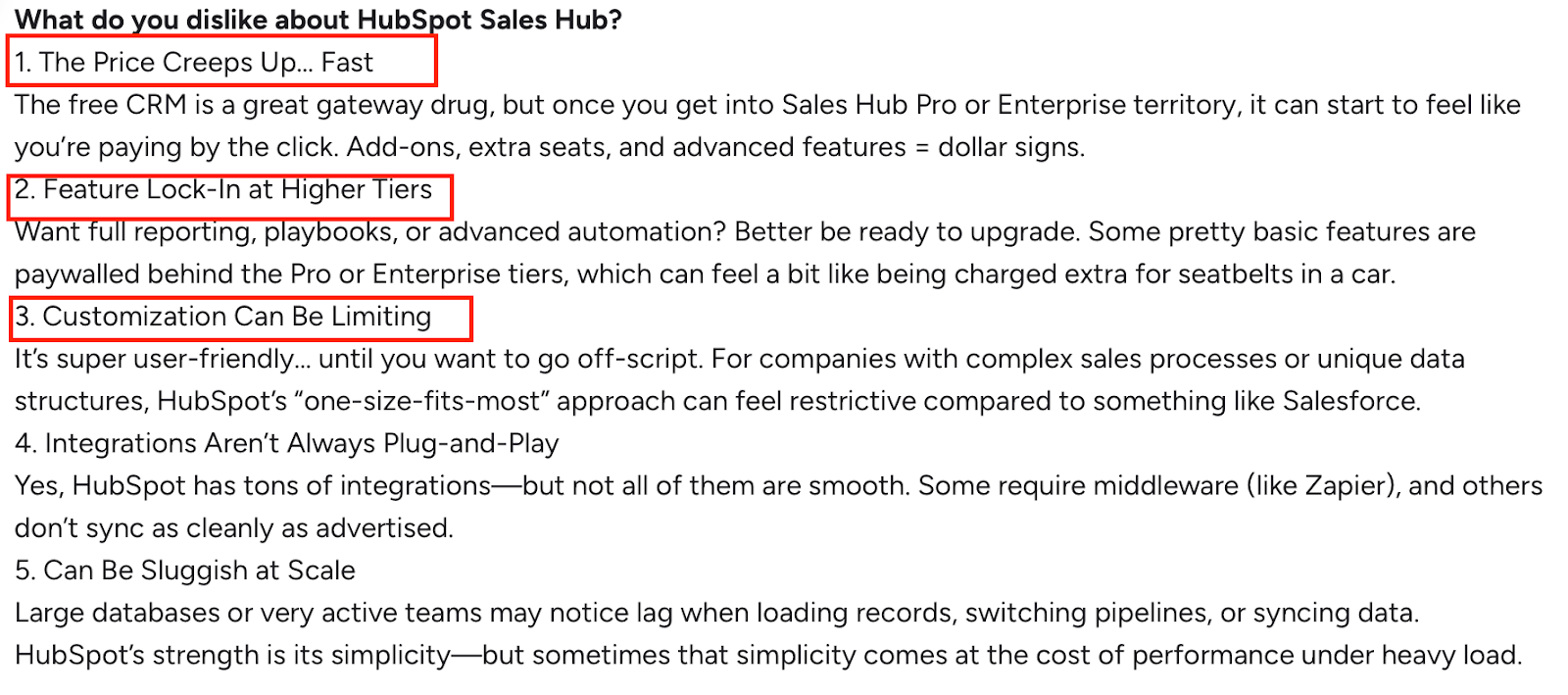
In short,
HubSpot Sales Hub is a comprehensive sales intelligence and CRM solution that helps teams with prospecting, automation, and pipeline management.
Its AI-powered features make it useful for identifying and prioritizing leads, while its integrations make it fit easily into a modern sales stack.
The downside is cost, especially for scaling businesses that need advanced features.
For 2025, it’s a strong option for companies that want everything in one platform and value built-in learning resources.
👉 Next, let’s move on to Gong, a tool best known for its conversation intelligence and AI-driven call analysis that supports smarter prospecting.
#7 Gong

Gong is included because it’s one of the leading AI-driven conversation intelligence platforms.
For prospecting in 2025, it adds value by recording and analyzing sales calls, highlighting buyer sentiment, and identifying action items.
This makes it easier for sales teams to understand what works in conversations and improve outreach strategies based on real data.
What Features Gong Offer?
- Call Recording & Transcription – Automatically records and transcribes sales and customer calls.
- AI Insights – Identifies talk ratios, key moments, and action items during conversations.
- Coaching Tools – Helps managers review calls and provide structured feedback to reps.
- Sentiment Analysis – Detects tone and reactions to improve messaging and prospecting approaches.
- Forecasting Support – Insights from conversations can feed into more accurate forecasts.
- Integrations – Works with popular CRMs and sales tools to track customer interactions in one place.
Pricing of Gong
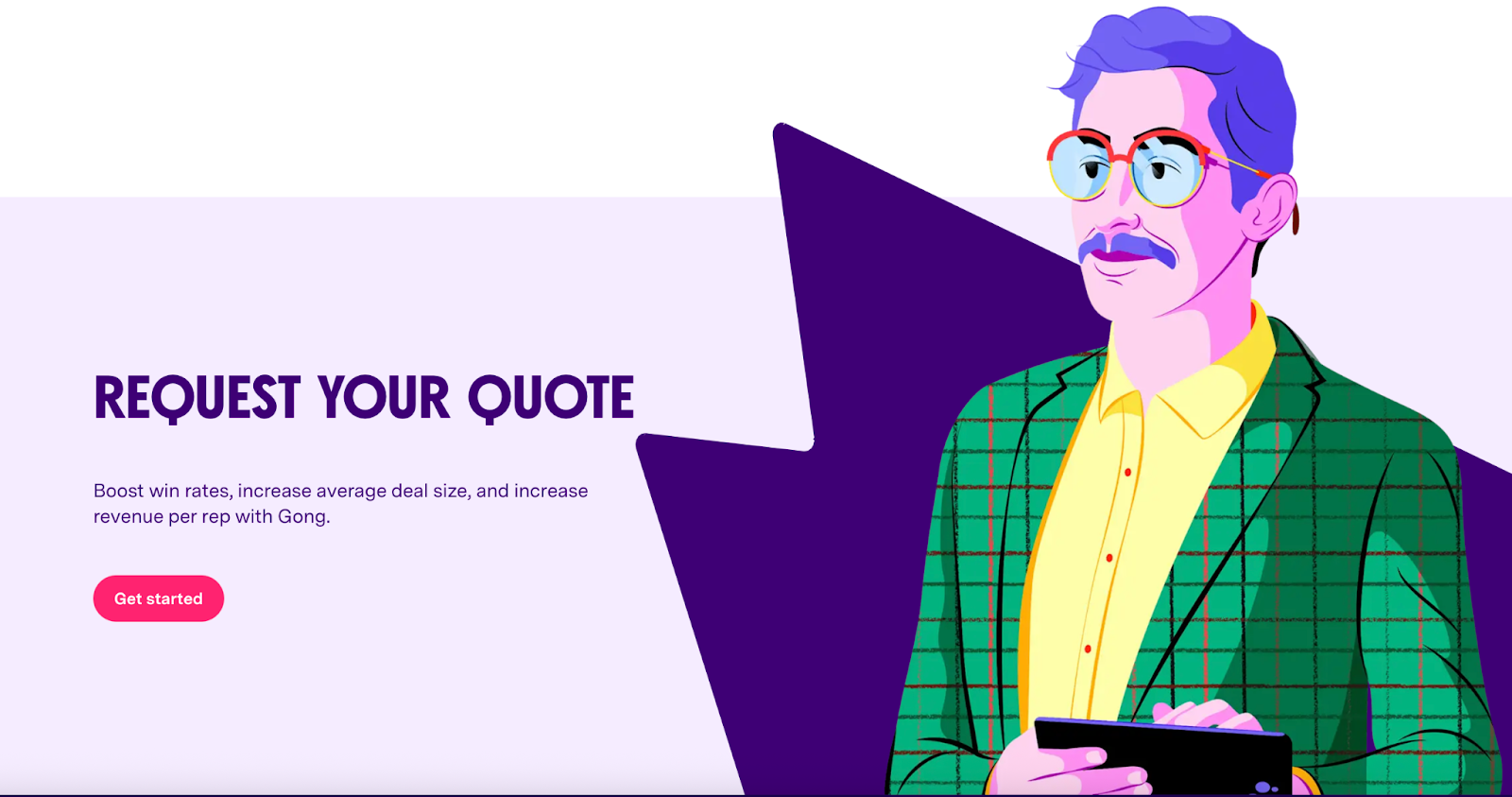
Gong does not publish fixed pricing. Costs are based on:
- Per-user licenses.
- Platform fee, which varies by company size.
- Custom quotes provided after scoping team size and requirements.
User feedback often notes Gong is expensive, especially for smaller companies.
Pros and Cons of Gong

In short,
Gong is best suited for teams that want AI-powered conversation intelligence to guide their prospecting and coaching efforts.
Its insights help sales reps improve discovery calls, tailor follow-ups, and close deals faster.
The main drawback is cost, which can make it harder to justify for small or mid-sized businesses.
In 2025, Gong remains a top choice for larger organizations that prioritize conversation data as part of their sales intelligence strategy.
👉 Next, let’s move on to Amplemarket, a tool known for its focus on accurate and frequently updated sales data.
#8 Amplemarket
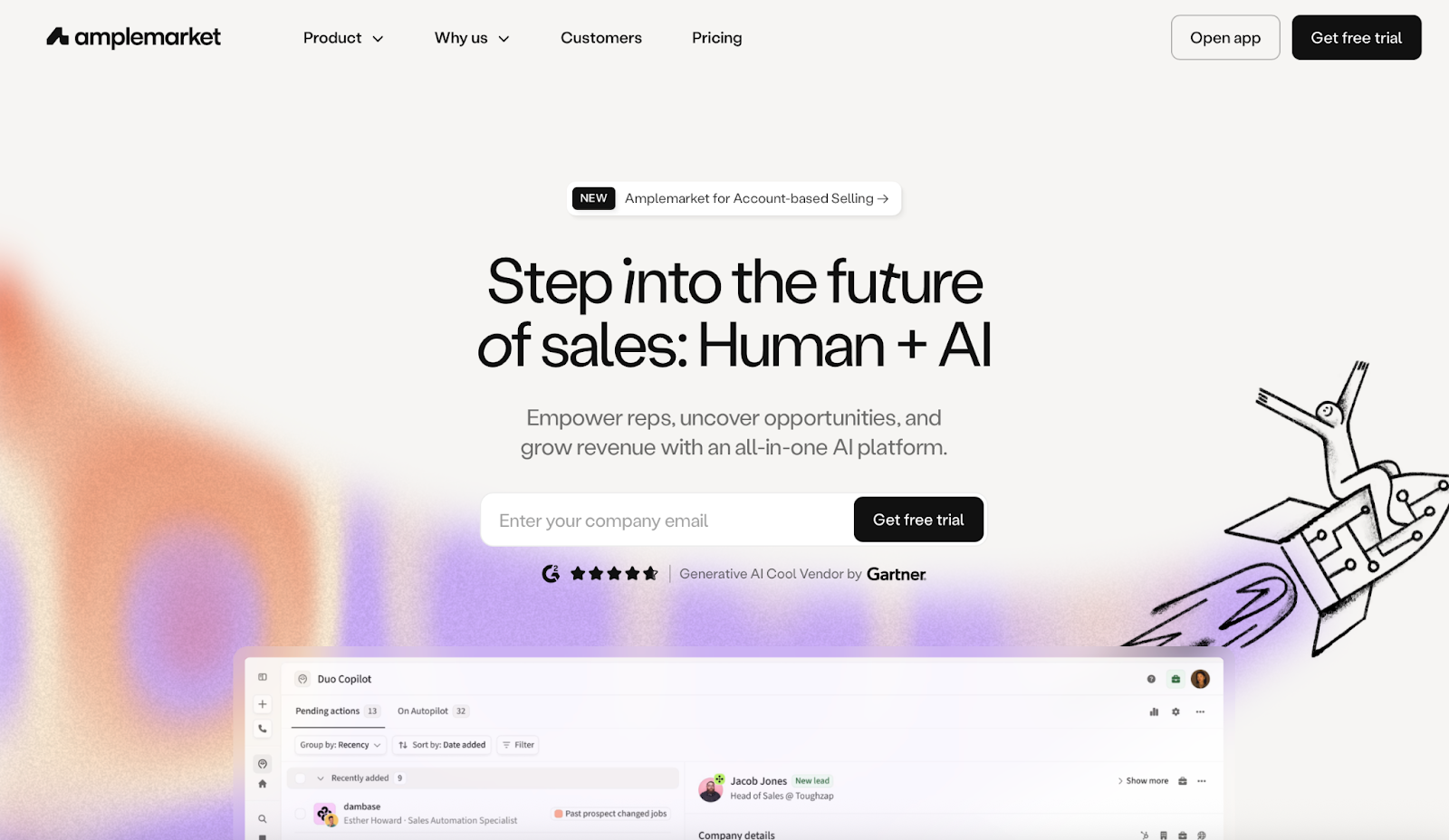
Amplemarket makes the list because it combines lead generation, AI sequencing, and intent data into one platform.
For teams that want to scale outbound prospecting, it automates repetitive tasks while providing signals on when prospects are most likely to engage.
This positions it as a strong option for companies looking to add more structure and efficiency to their sales intelligence stack in 2025.
What Features Amplemarket Offer?
- AI Intent Signals – Surfaces prospects showing buying intent through online activity.
- Duo Copilot – AI assistant for writing and sequencing personalized outreach.
- Duo Voice & Duo Inbox – Adds voice messages and AI-generated draft replies to multichannel workflows.
- Large B2B Database – Verified contacts with enrichment options like technographics and job changes.
- Deliverability Optimization – Domain health monitoring, spam checking, and mailbox recommendations.
- CRM Integrations – Works with common sales platforms to sync data and activity.
Pricing of Amplemarket
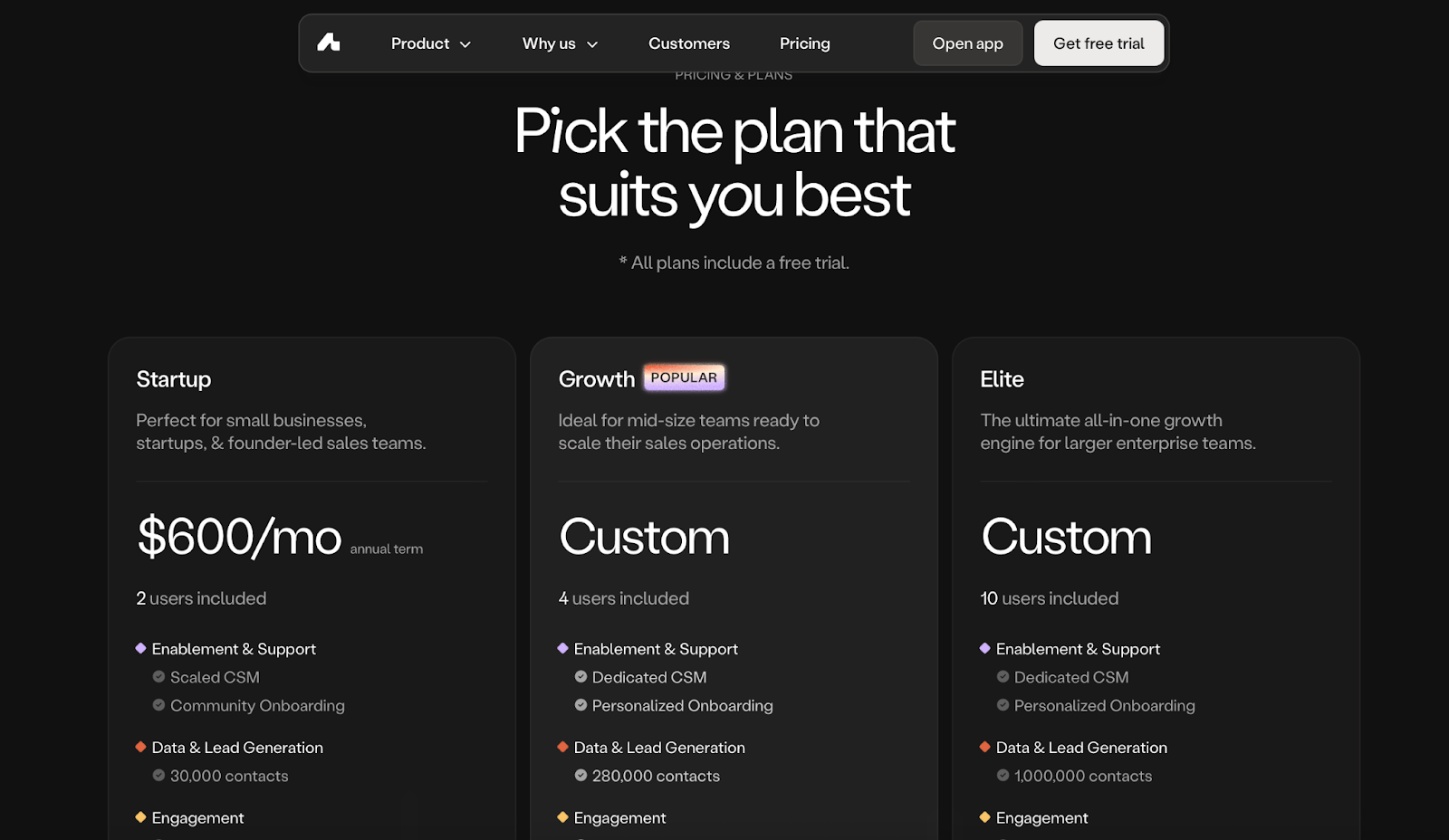
- Startup Plan – $600/month (annual term, includes 2 users and 30,000 contacts).
- Growth Plan – Custom pricing (4 users included, 280,000 contacts).
- Elite Plan – Custom pricing (10 users included, 1,000,000 contacts).
All plans include multichannel sequences, AI features, and onboarding support. Add-ons like custom data requests or competitive intelligence vary by tier.
Pros and Cons of Amplemarket

In short,
Amplemarket is a fit for teams that want AI-guided prospecting at scale.
Its strength lies in combining intent signals, automation, and enrichment in one platform.
While it isn’t the cheapest option, and results may vary depending on niche, it’s a solid choice in 2025 for companies that want to speed up outbound while keeping personalization and deliverability in check.
5 Best AmpleMarket Alternatives & Competitors for Cold Email Outreach

.png)

.png)

.png)